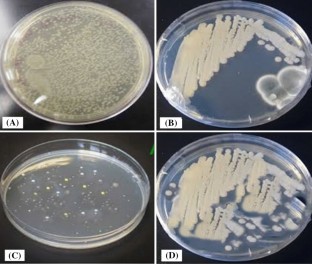Proximate composition of orange peel, pea peel and rice husk wastes and their potential use as antimicrobial agents and antioxidants
Naqvi Syeda Andleeb Zahra, Irfan Ali, Zaheer Saima, Sultan Aeysha, Shajahan Shanavas, Rubab Syeda Laila, Ain QuratUl, Acevedo Roberto
Research Articles | Published: 02 April, 2021
First Page: 470
Last Page: 476
Views: 3880
Keywords: Agro-waste, Antibacterial, Antifungal, Antioxidant, Phytochemicals
Abstract
The proximate composition of extracts from three selected agro-wastes (rice husk, pea peels and orange peels) was determined by following AACC protocols. All wastes were found to have intrinsic phytochemical compositions which are responsible for their antimicrobial and/or antioxidant potential. Amongst the wastes, orange peel had largest amount of total phenolic content as well as total flavonoid content. The highest values for total phenolic and flavonoid contents were consistent with the most significant antioxidant potential observed for orange peel. Although FRAP values were in agreement with the scavenging assays, but the reducing power in terms of total antioxidant capacity was highest for pea peel extracts. The wastes also exhibited significant inhibition against selected fungal and bacterial stains which suggest that these samples could be good antimicrobial source.

References
- Anna C, Ewa Z, Dmytro Y, Zvenyslava Z, Izabela G, Sylwia K (2020) Mineral content of the pulp and peel of various citrus fruit cultivars. Biol Trace Elem Res 193:555–563
- Asfour HM, Fadali O, Nassar MM, El-Geundi MS (1985) Equilibrium studies on adsorption of basic dyes on hard wood. J Chem Technol Biotechnol 35:21–27
- Benzie I, Strain J (1999) Methods in enzymology. Academic Press, New York, pp 15–27
- Bhattacharjee S, Sultana A, Sazzad MH (2013) Analysis of the proximate composition and energy values of two varieties of onion (Allium Cepa L.) bulbs of different origin: A comparative study. Int J Nutr Food Sci 2(246):253
- Brewer M (2011) Comprehensive reviews in food science and food safety. Wiley, Hoboken, pp 221–247
- Choudhary MI, Parveen Z, Jabbar A, Ali I (1995) Antifungal steroidal lactones from Withania coagulance. Phytochemistry 40:1243–1246
- Daud Z, Hatta MZM, Kassim ASM, Awang H, Aripin AM (2014) Exploring of agro waste (pineapple leaf, corn stalk, and napier grass) by chemical composition and morphological study. BioResources 9(1):872–880
- Dilas S, Čanadanović-Brunet J, Ćetković G (2009) By-products of fruits processing as a source of phytochemicals. Chem Ind Chem Eng Q 15:191–202
- Gorinstein S, Martín-Belloso O, Park YS, Haruenkit R, Lojek A, Ĉíž M, Caspi A, Libman I, Trakhtenberg S (2001) Comparison of some biochemical characteristics of different citrus fruits. Food Chem 74:309–315
- Indrayan A, Sharma S, Durgapal D, Kumar N, Kumar M (2005) Determination of nutritive value and analysis of mineral elements for some medicinally valued plants from Uttaranchal. Curr Sci 89:1252–1255
- Kamran G, Yosef G, Mohammad AE (2009) Antioxidant activity, phenol and flavonoid contents of 13 citrus species peels and tissues. Pak J Pharm Sci 22:277–281
- Khitma AE, Randa AAE, Amro BH (2018) Content of phenolic compounds and vitamin C and antioxidant activity in wasted parts of Sudanese citrus fruits. Food Sci Nutr 6(5):1214–1219
- Mayra A, Jesus B, Ana F, Maria JE (2020) High biological value compounds extraction from citrus waste with non-conventional methods. Foods 9:811
- Navarro V, Villarreal ML, Rojas G, Lozoya X (1996) Antimicrobial evaluation of some plants used in Mexican traditional medicine for the treatment of infectious diseases. J Ethnopharmacol 53:143–147
- Ozgen M, Reese RN, Tulio AZ, Miller AR, Scheerens JC (2006) Modified 2,2-Azino-bis-3-ethylbenzothiazoline-6-sulfonic Acid (ABTS) method to measure antioxidant capacity of selected small fruits and comparison to ferric reducing antioxidant power (FRAP) and 2,2‘-Diphenyl-1-picrylhydrazyl (DPPH) methods. J Agric Food Chem 54:1151–1157
- Park JH, Lee M, Park E (2014) Antioxidant activity of orange flesh and peel extracted with various solvents. Prev Nutr Food Sci 19:291–298
- Poots VJP, McKay G, Healy JJ (1976) The removal of acid dye from effluent using natural adsorbents II: wood. Water Res 10:1067–1070
- Prieto P, Pineda M, Aguilar M (1999) Spectrophotometric quantitation of antioxidant capacity through the formation of a phosphomolybdenum complex: Specific application to the determination of vitamin E. Anal Biochem 269:337–341
- Rangana (2019) Manual analysis of fruits and vegetables product. Tata McGraw Hill Co. Ltd., New Delhi, pp 634
- Rudra SG, Nishad J, Jakhar N, Kaur C (2015) Food industry waste: mine of nutraceuticals. Int J Sci Environ Technol 4:205–229
- Singleton VL, Rossi JA Jr (1965) Colorimetry of total phenolics with phosphomolybdic-phosphotungstic acid reagents. Am J Enol Vitic 16:144–158
- Soong YY, Barlow PJ (2004) Antioxidant activity and phenolic content of selected fruit seeds. Food Chem 88:411–417
- Thaipong K, Boonprakob U, Crosby K, Cisneros ZL, Hawkins D (2006) Antioxidant activities of various seed extracts from four varieties of rambutan (nephelium lappaceum) using dpph and abts assays. J Food Compos Anal 19:669–675
- Thangaraj P (2015) Pharmacological assays of plant-based natural products. Springer, Berlin, pp 21–31
- Voudrias E, Fytanos K, Rozani E (2002) Sorption-desorption isotherms of dyes from aqeous solutions and waste water with different sorbent materials. Int J Chem 4:75–83
- Yahia EM (2010) The contribution of fruits and vegetables to human health. In: De la Rosa L, Alvarez-Parrilla E, Gonzalez-Aguilar G (eds) Fruit and vegetable phytochemicals: chemistry, nutritional value and stability. Wiley, Ames, pp 3–51
- Yahia EM (ed) (2017) Fruit and vegetable phytochemicals: chemistry and human health. Wiley, Ames
Author Information
Department of Chemistry, University of Lahore, Sargodha, Pakistan